Yesterday, a week to the day since the previous train to Abbeville, I was scoping out the Louisiana & Delta Railroad yard in New Iberia thinking that there would be an Abbeville Branch train that day, and there somewhat was, as the next train for the Abbeville Branch was made and then brought onto the beginning of the branch and tied down.
So, therefore, today, Friday 16 August 2019, I was nearly certain that there would be a train on the branch and prepared for such.

At 13:50 CDT, I caught the headlight of the approaching westbound train at the Longside Road crossing east of Delcambre at Bob Acres.
With the midday lighting still being harsh, with me being hungry, with the train needing to stop at the Delcambre Canal bridge, and with catching up with the train if I it were to get ahead of me, I chose to stop at the Subway across the highway from the track in Delcambre and get something to eat.
At 14:11, I emerged from Subway and shot a couple of views of the train from the parking lot.

Well, that’s not quite the same as the Subway by the track on Fourth Street in Gretna, but it’s still okay!
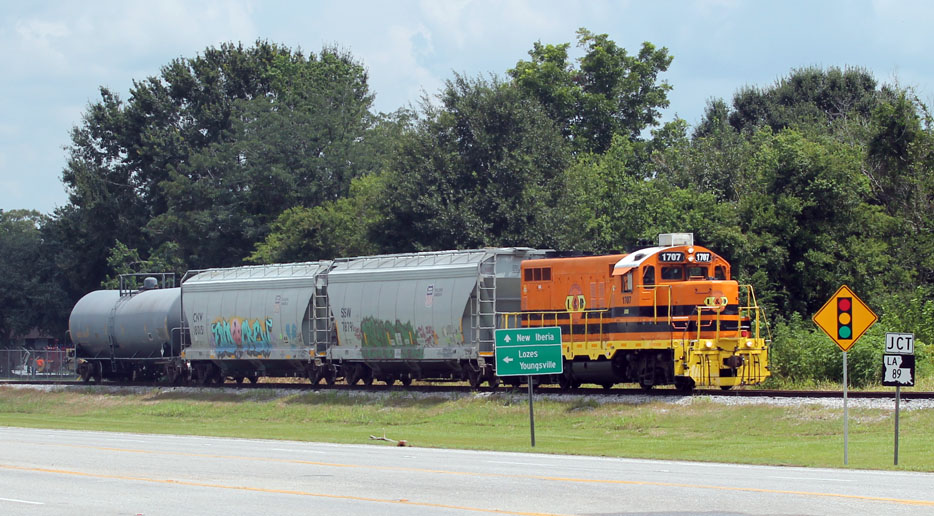
Dammit! I really could do without that stupid graffiti on the cars. I hate graffiti. I am going to have to choose to get shots that are more head-on than I would like so as to minimize the views of that graffiti, but, actually, I’m going to be on the other side of the train anyway.
So, my first really-set-up shot is at South Barras Street in Erath as the train crosses Jude Road.
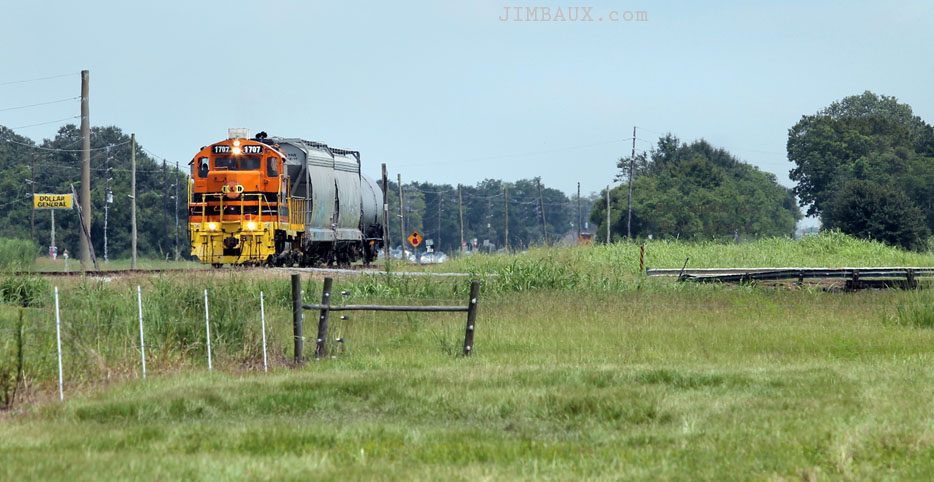
If there would ever be long trains on this branch anymore, this would be a decent place to photograph them.

Dammit! There is graffiti on this side of the cars, too! (I should have known that from seeing them yesterday, but it was dark.) I’m just going to have to do really head-on pictures for the rest of the way to the mill.
Okay, is this train going to pick up either or both of these boxcars that have been sitting here, the one closest to me for two weeks and the other for three weeks, at West Erath and bring them to the mill today?
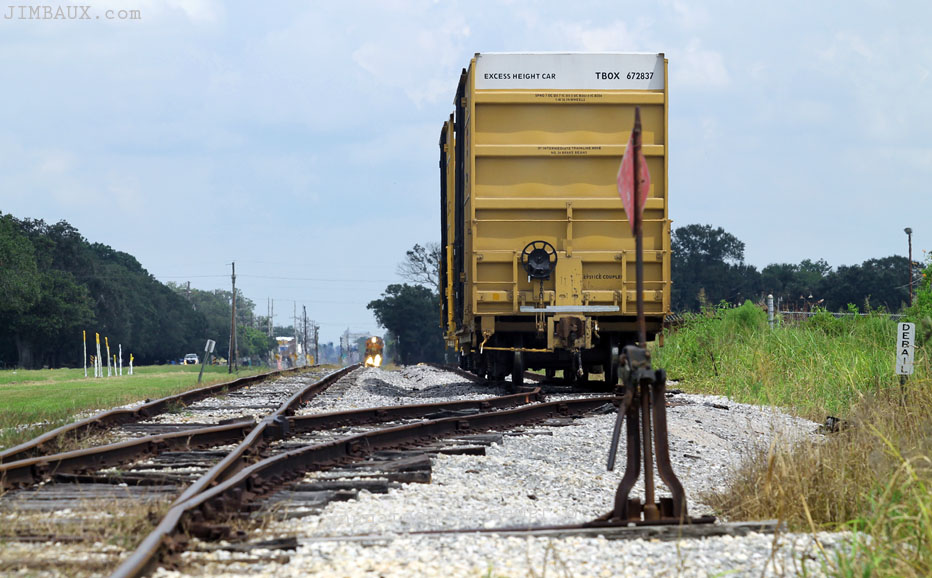
The moment of truth is upon us.
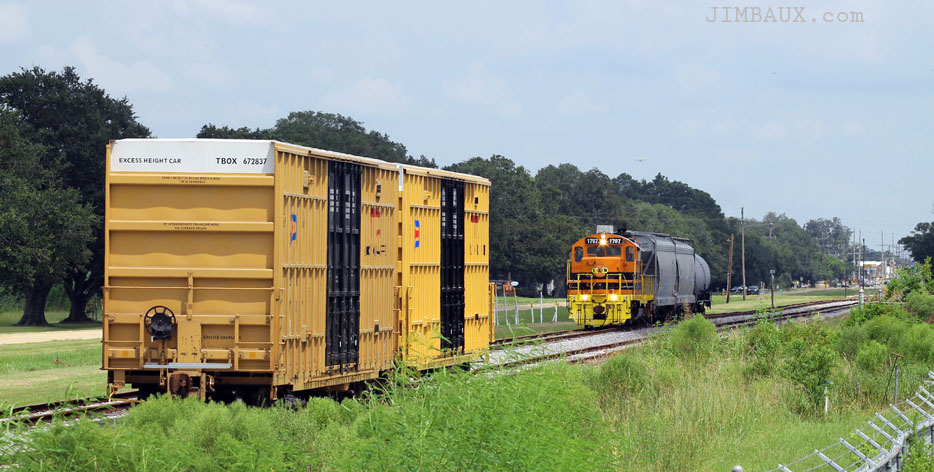
Well, look at that. I am at South Hospital Road in eastern Abbeville, and this is what I see.
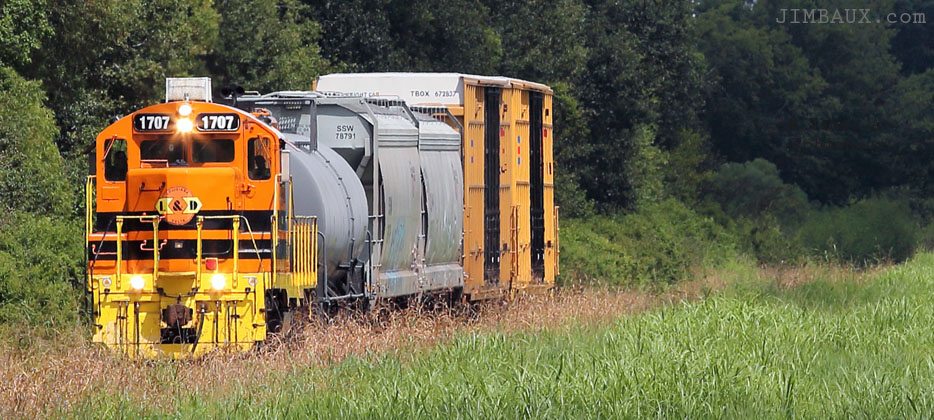
That is some telephoto goodness!
Not only did the crew pick up both boxcars, but it also rearranged the other cars to put the tank car at front.
Clouds move in before the train is in position for me to take the wider shot for them same location.
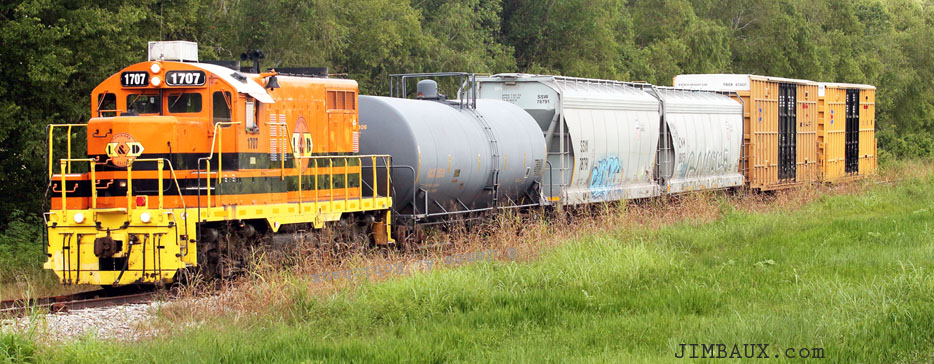
In the older residential area in the eastern part of town, which reminds me of the neighborhood of my youth with the branchline railroad track running through it, I tried something different that would not show the graffiti.
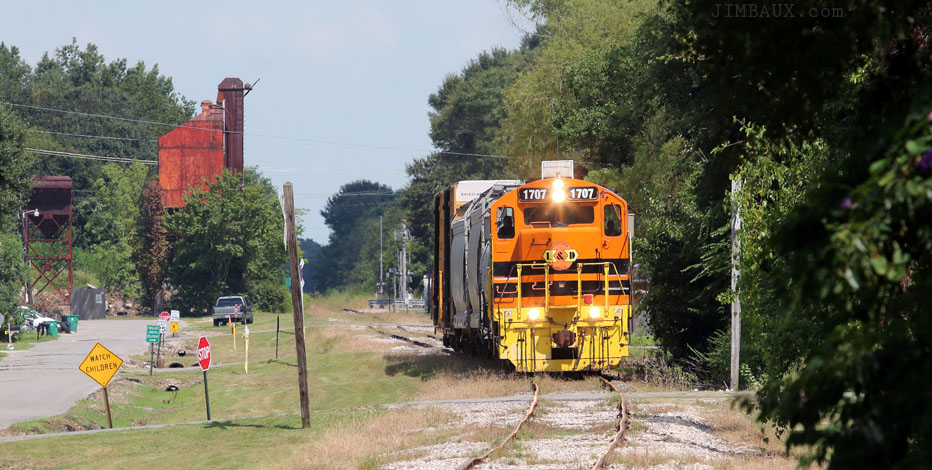
I like it! It shows the ‘wrong’ – i.e., shaded – side of the train, but it works!
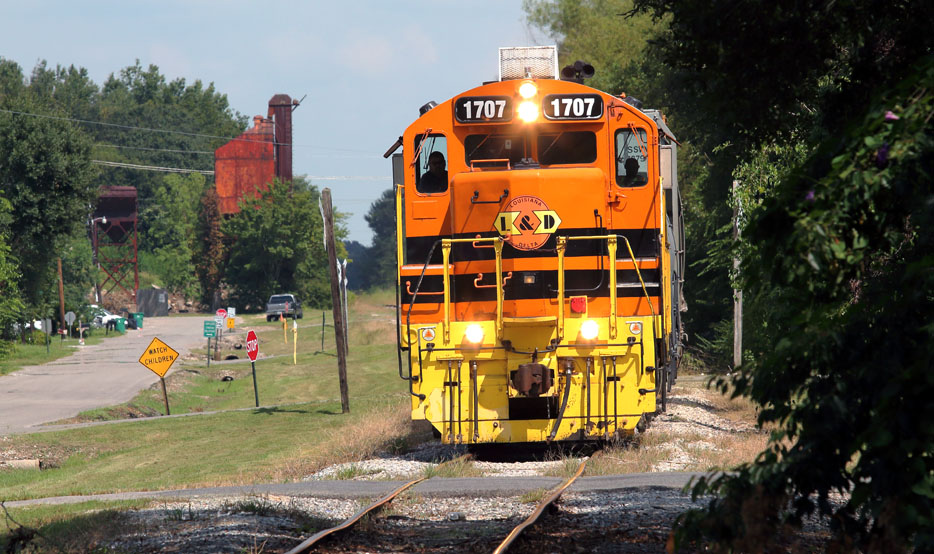
The gravel tipple in the background plus the jointed rail help to make the shot.
Okay, my next stop is at the mill, where, true to form, what appears to be a rice truck is moving west.
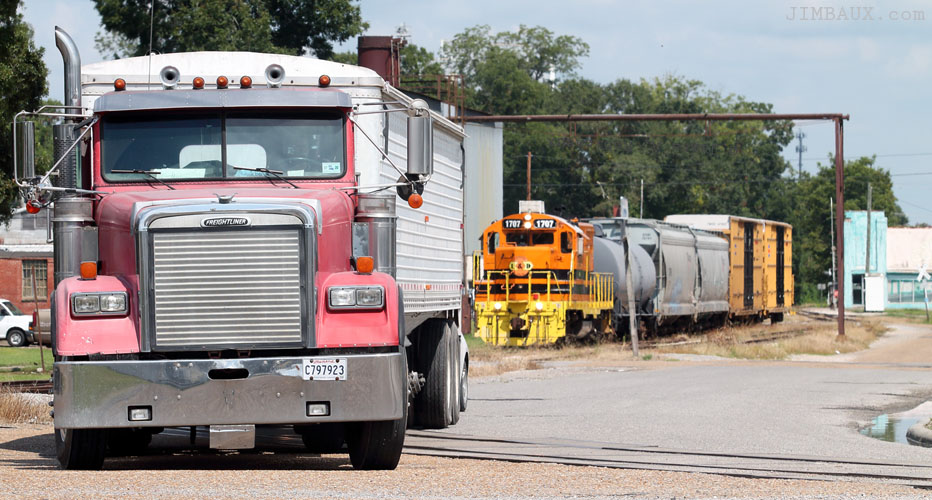
Once it passes, let’s get the broader, unobstructed view that shows the tracks at the mill at right, the old hull loader at left, and the track in the foreground to the packaging plant next to Bayou Vermilion.
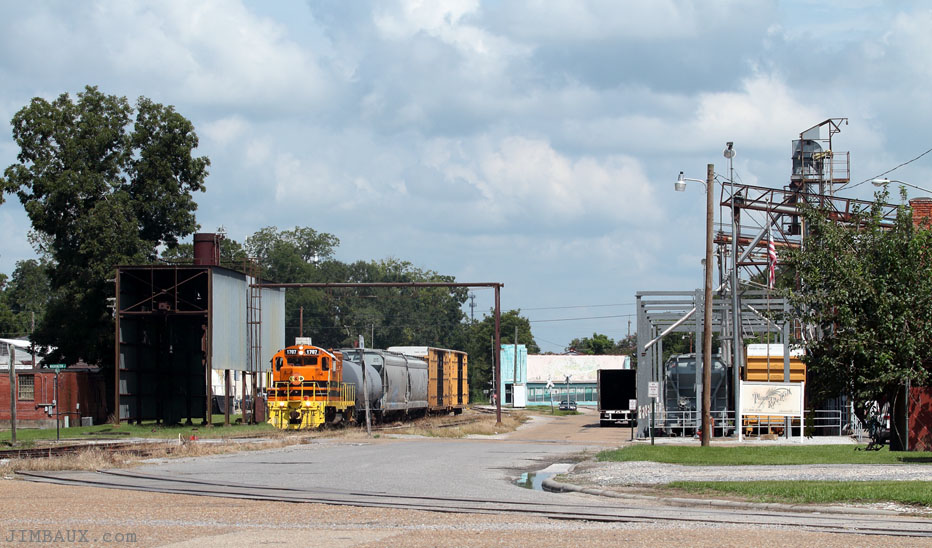
That’s cool, and I am coming to love that big tree at the left, but let’s also see a cropped version of that image.
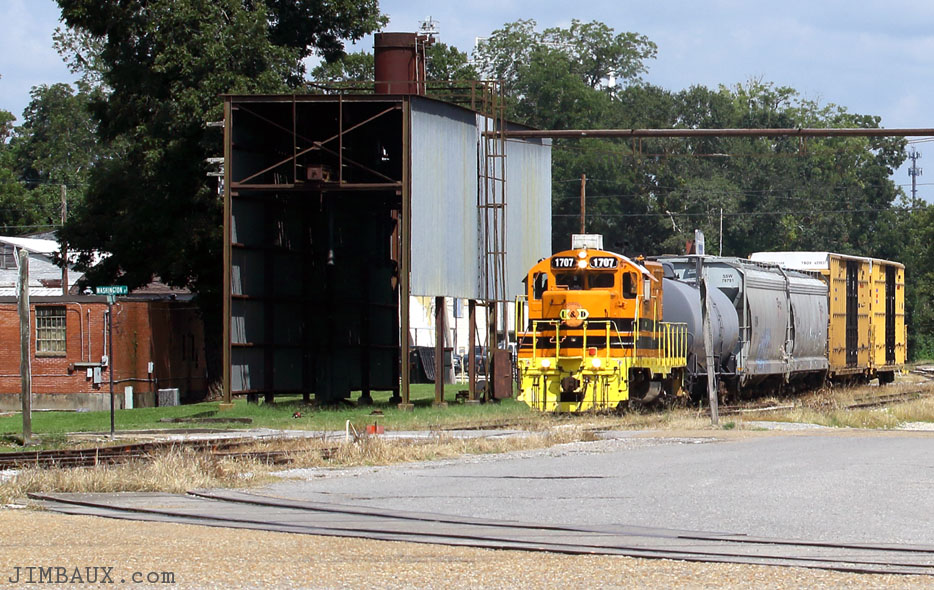
The trainman walks across Railroad Avenue to the mill.
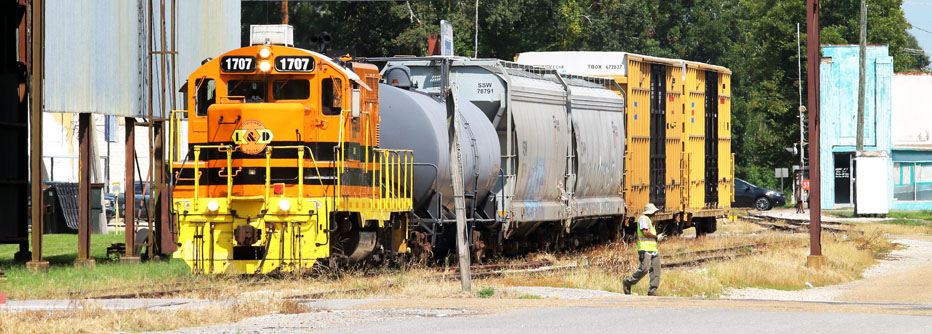
For some reason, perhaps due to the striking nature of the body style of that white sedan, I wanted to show the below image with the sedans in front of the train.
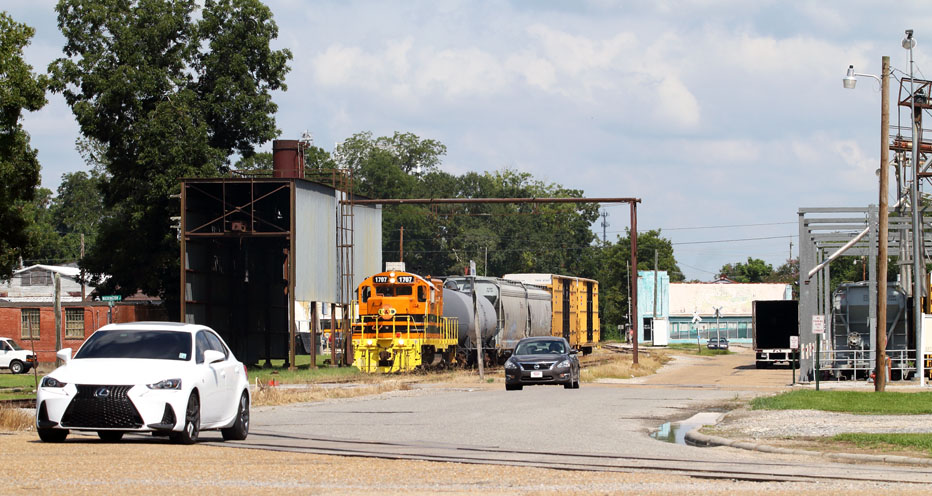
With the sedans coincidentally out of the way, the LDRR 1707 breaks off from its inbound train, the switching work at the mill about to begin.

The first thing that the crew does is go toward the former packaging plant, the part of the mill complex next to Bayou Vermilion.
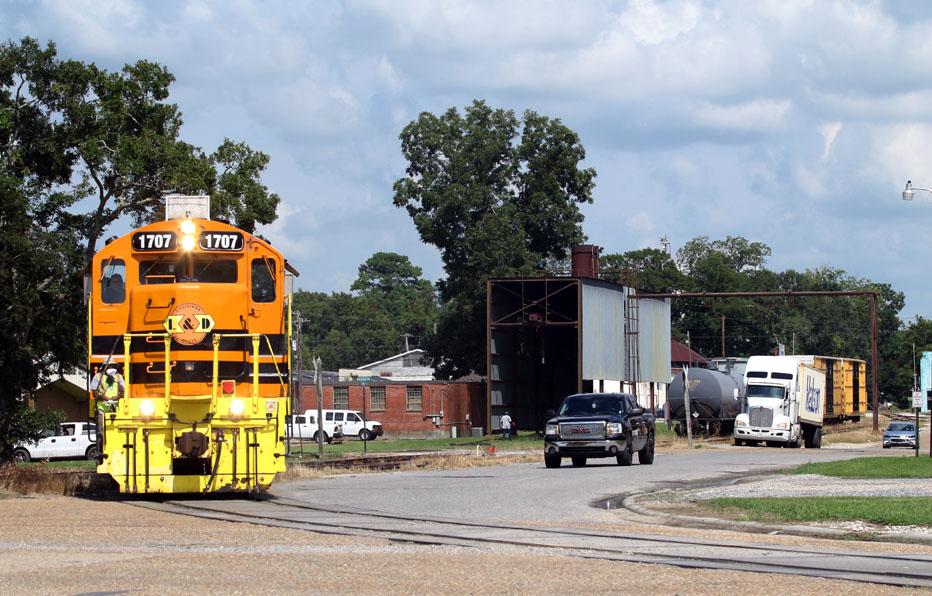
Let’s see a cropped view of that image.
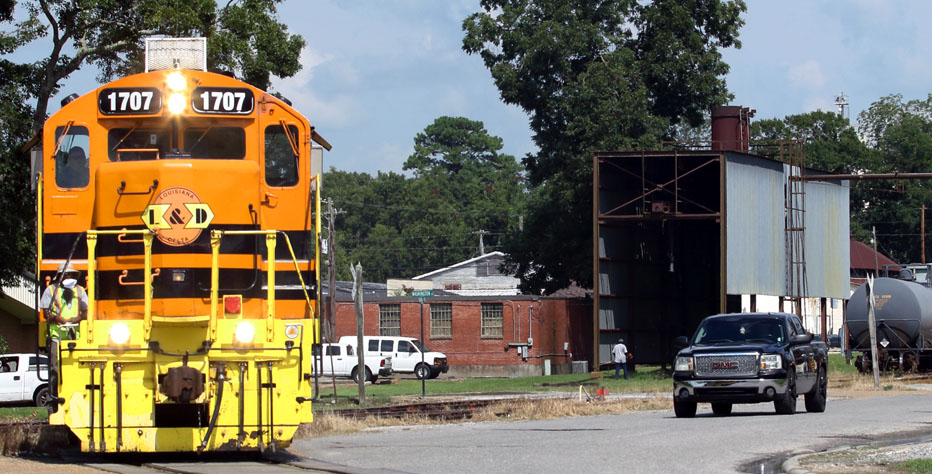
There were three cars at the packaging plant track. The one closest to the locomotive was not yet loaded; so, the crew would pull the cut of three cars out, set the two outbound cars (at least one of them appeared to not be loaded, perhaps being bad ordered) out on the branch mainline, and then respot the first car.
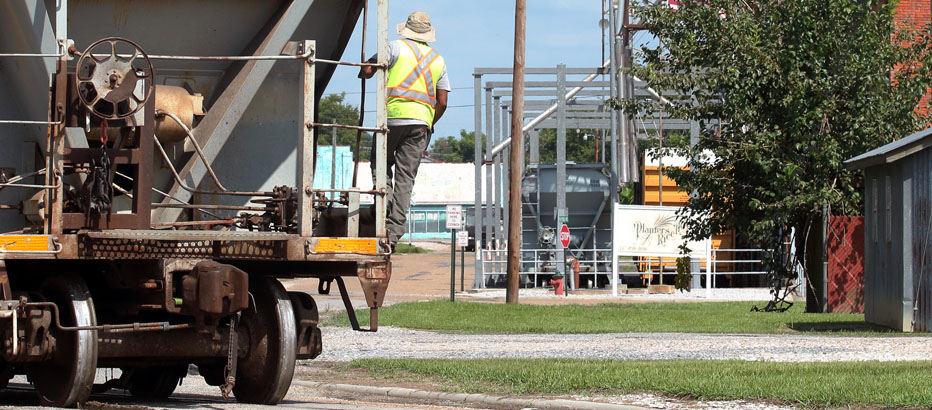
Here, the cut of three cars is being pulled, and blow is a cropped version of the above image.
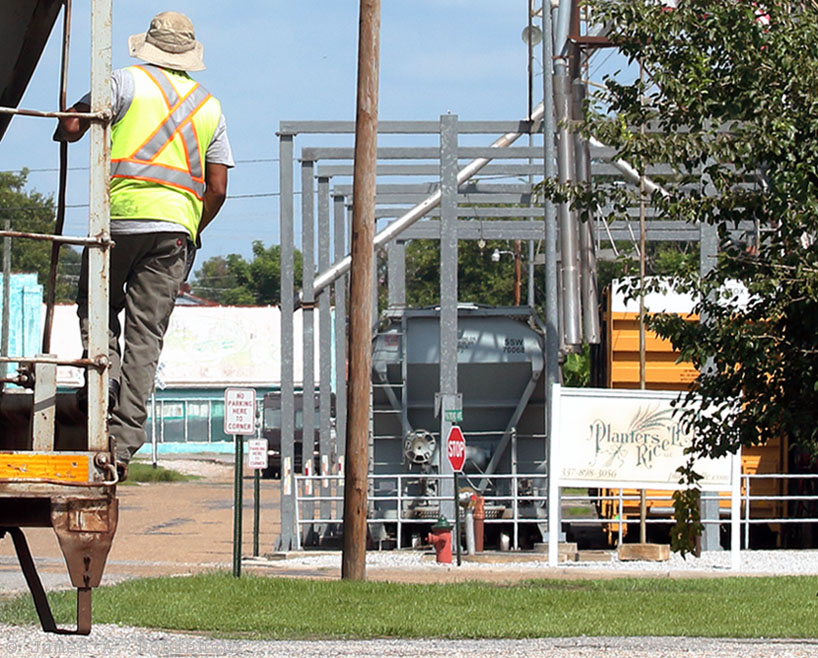
Today, when there is not enough space at the tracks at the main mill complex that you see in the backgrounds of these images, the mill trucks rice across the street (well, across two streets) to the former packaging plant to load rice into hopper cars there, but, until a few decades ago, the packaging plant was where most or all of the boxcars that the mill loaded were loaded.
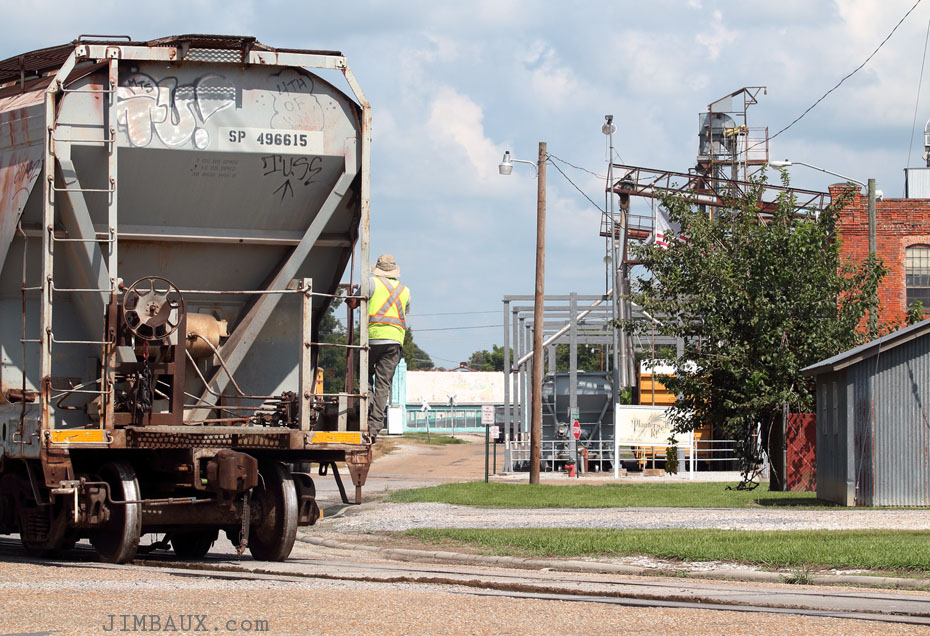
So, this (below) is where the crew left the other two cars, the two outbound cars, at least one of which may be bad ordered, and I like the S-curve effect of the track, punctuated by having actual railroad cars that just used that track sitting in the background.
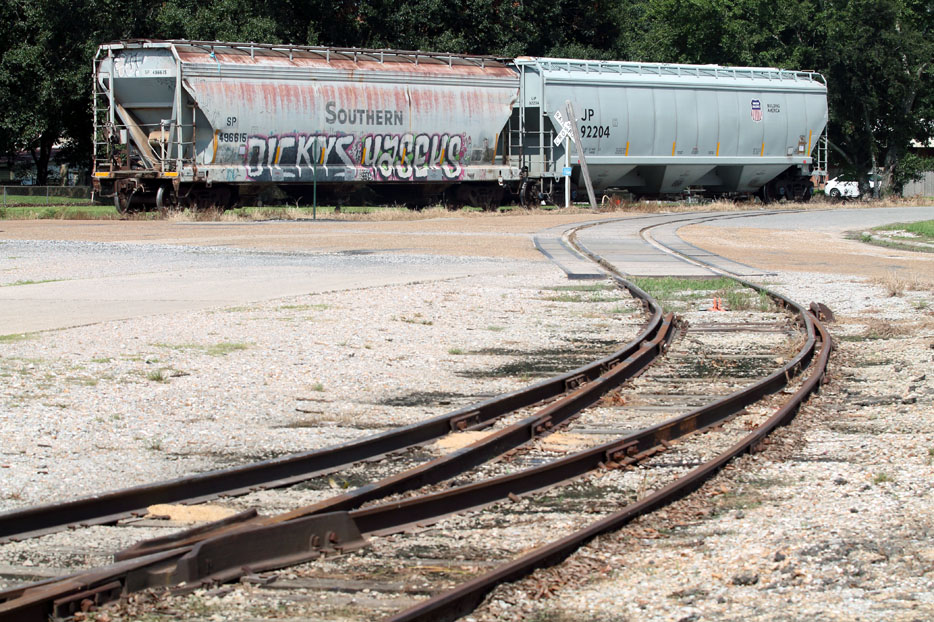
Look, I know that you white-bread railroad enthusiasts who still read this site think that I am some commie, Lefty, liberal hippie, and I know that you liberal and progressive folks whom I have managed to convince to look at my train pictures think that I would be naturally okay with any artistic expressions of the powerless, but if there is one way to bring out my inner capitalist, my inner defender of private-property rights, it’s to in any way glorify or legitimize graffiti on railroad cars.
If you find out that I like trains and that I like photographing them, and your response is to ask me about photographing or seeing neat graffiti on railroad cars, I just don’t want to talk to you anymore.
What is especially bad in this particular example is that the car with the offending hen scratching in the above image is one of the rare cars that still has the old big “SOUTHERN PACIFIC” lettering on the sides. The railroad logos, increasingly rare on rolling stock, is part of the “artwork” that attracts me and others to railroad enthusiasm in the first place. Were it not for the graffiti on that particular car, I would have worked that car into as many of these images (and when it arrived on the train that came to the mill a week ago) as I possibly could have here.
So, in this case, a choice to deface that particular car is a choice to deface a historical artifact. I have zero patience or “understanding” for something like that. If graffiti ‘artists’ and their defenders cannot be expected to know which cars are “historic” and which are less so, then no graffitiing of cars is defensible.
This is not to say that the graffiti sketchings are completely devoid of artistic merit, that the persons who draw them lack talent, or that there is not a place in society for such drawings, but it is to affirmatively say that this is not the place for them. That the people who do such drawings likely are oppressed and likely don’t have any other outlets for their talents and their frustrations is not my nor the railroads’ problem; I mean, it is “my problem” as a fellow citizen, but it’s not my problem as a railroad enthusiast, and, for me, this ‘hobby’ as it is is supposed to be a break from real life.
I just don’t understand why so many of the educated progressive-liberal people I encounter about my railroad enthusiasm think that defacing railroad cars is okay.
It’s not okay.
Anyway, now that those two cars at left are out of the way, the 1707 and crew can put the first car back onto the packaging plant track from which they had just pulled it.
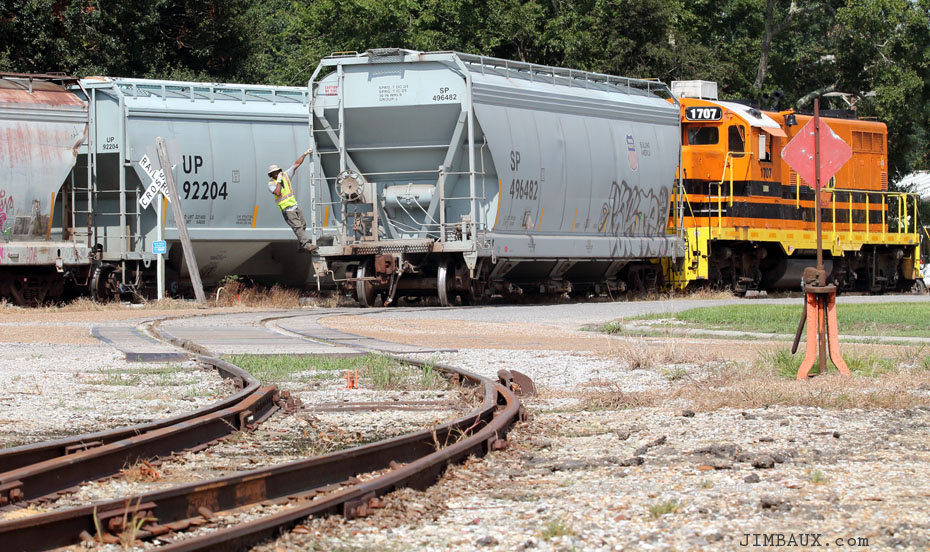
Below is a cropped version of the above image.
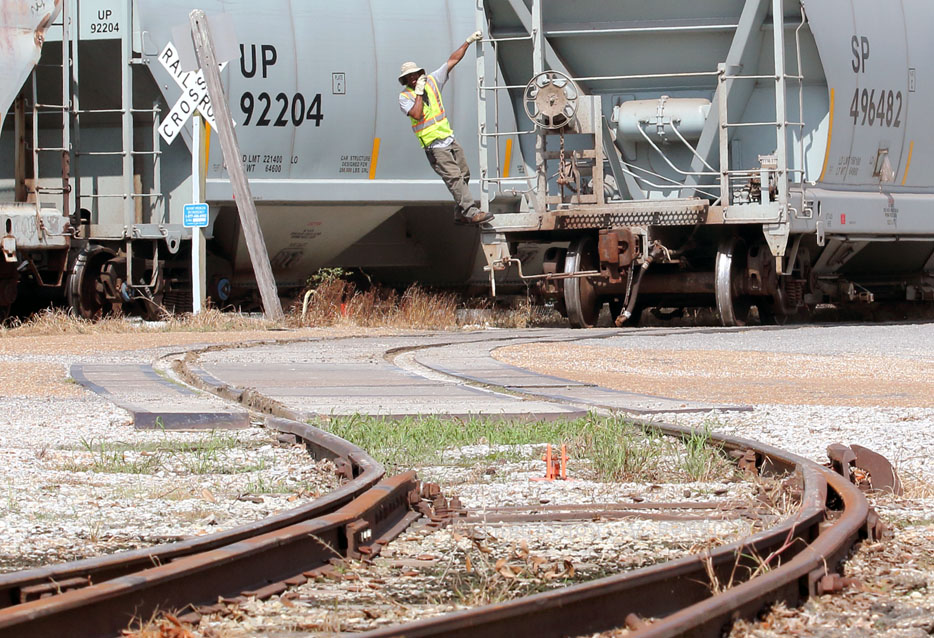
I wish that all of these cars had the big lettering on the sides, and none of them with graffiti.

Momentarily, the locomotive is hidden!
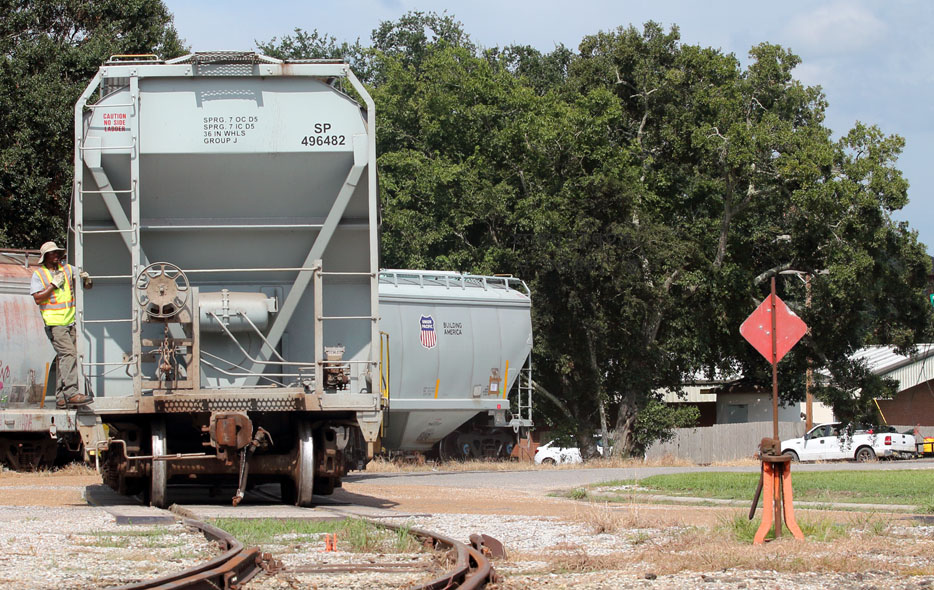
Let’s see a cropped version of that image.
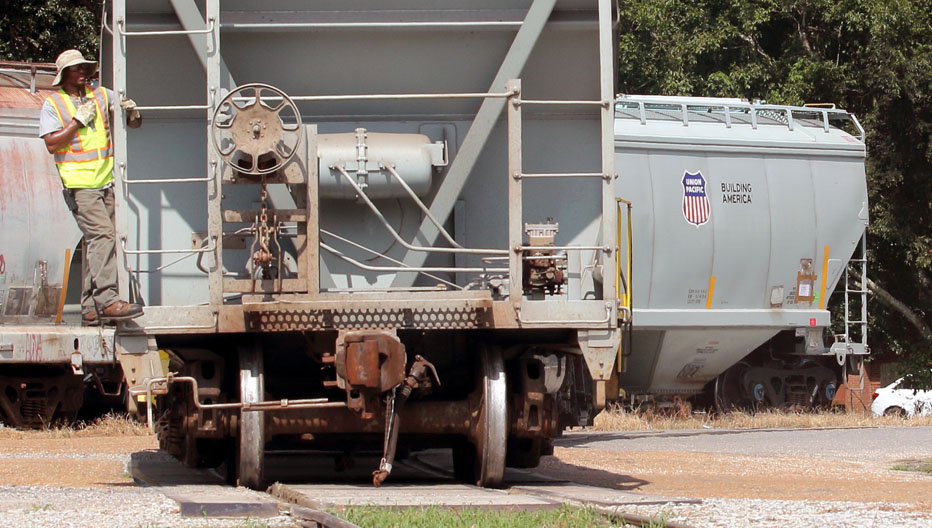
It’s braketime.
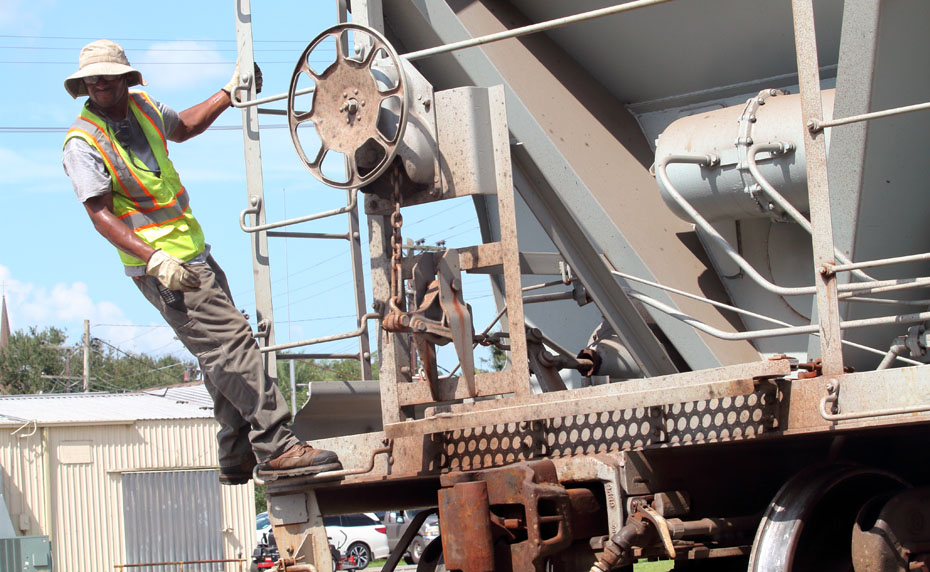
The graffiti makes me angry, but this makes me uncomfortable.
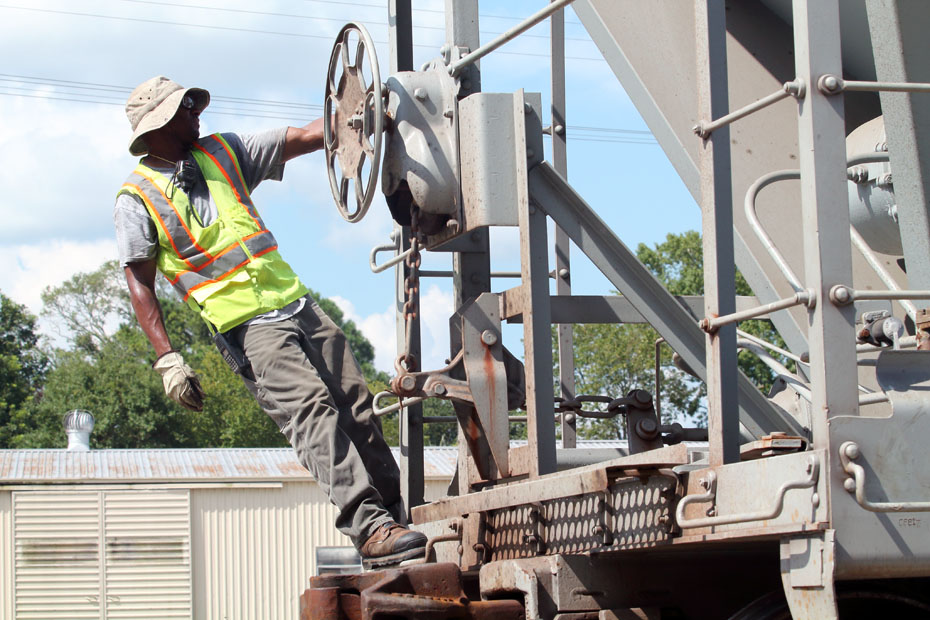
With that car set back out, it’s time for the 1707 to grab the two other cars pulled from the former packaging plant to pull them eastward to the runaround track.
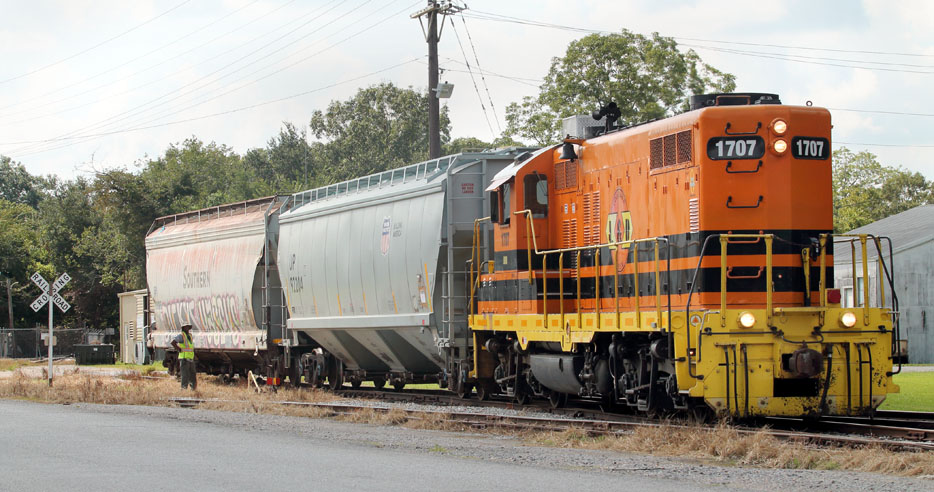
At this point, I broke off and went to the homestead, I think because I was out of water and was getting quite thirsty in this heat.
On my way back to the mill, I got this shot looking southward along State Street past the courthouse as the 1707 was switching boxcars.
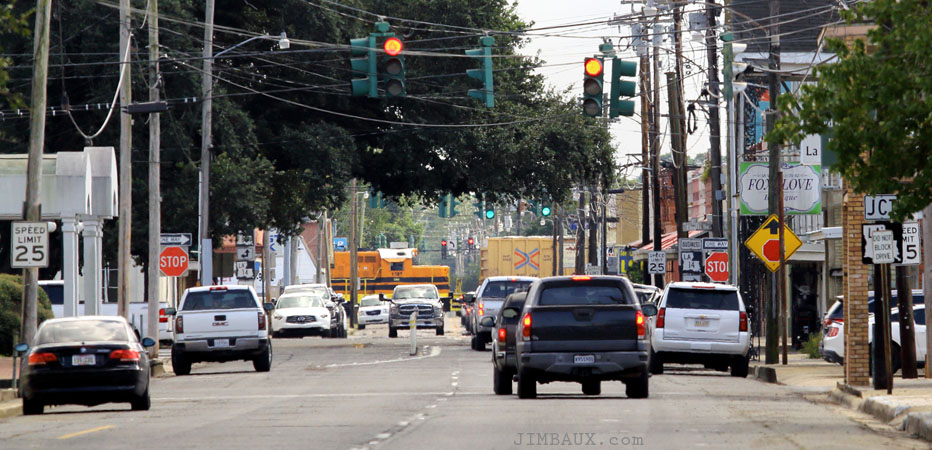
Let’s see that closer.
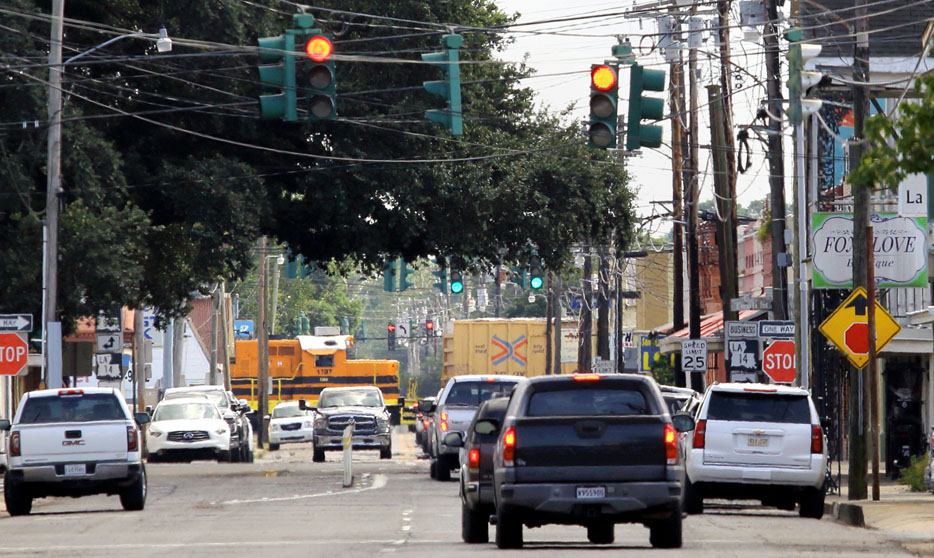
Okay, most of what will be the outbound train is now built, but at least one of those boxcars needs to be (re)spotted.
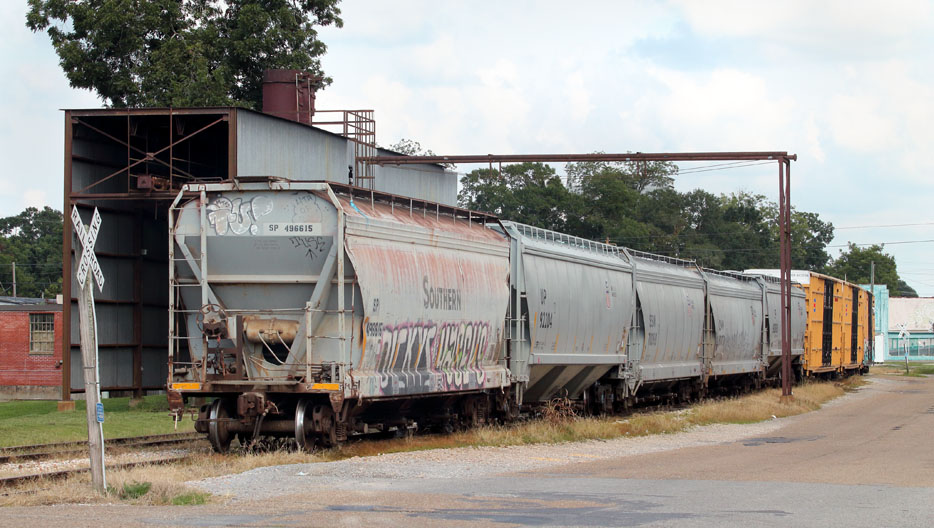
Below, with the outbound train now built, it’s time to spot cars at the main mill.

One of those boxcars was part of the cut of cars at left, which now has the tank car added to it, meaning that the outbound train is now fully made and that all of the cars attached to the locomotive now are to be left somewhere at the mill in these two tracks in the foreground.
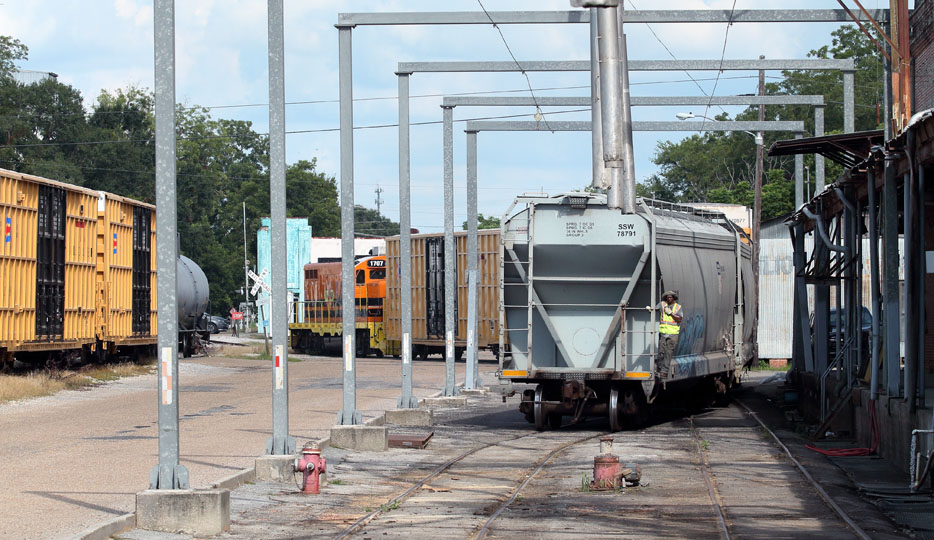
Our man is now on the ground watching the shove come my way.
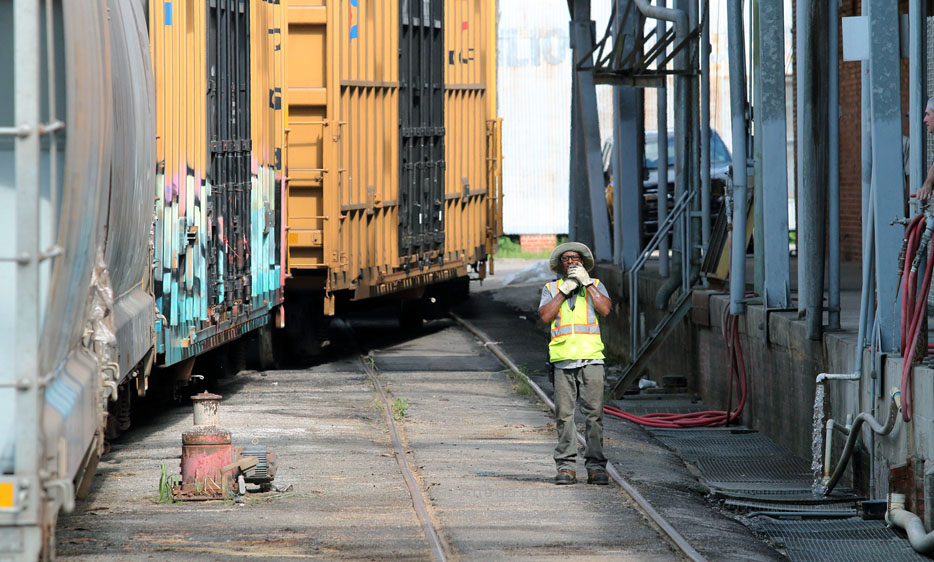
Okay, with that done, with the boxcars spotted, the locomotive and crew are now leaving the mill, the day’s railroad work done there, and are about to grab their outbound train and leave.
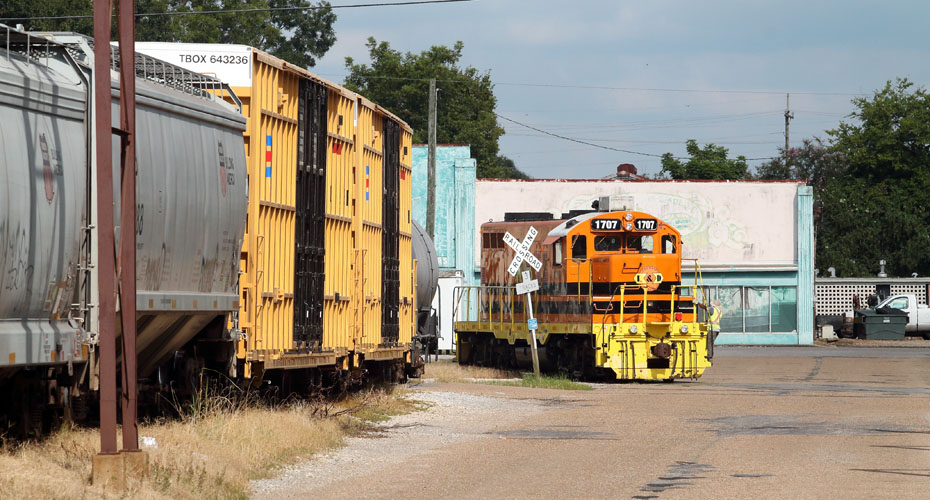
The train leaves the mill.
The challenge that I now face is that the train will, for the next 15 miles, be moving close to due east in the late afternoon, making the lighting really tricky.
I set up for a shot at South John M. Hardy Drive, where the track is seven degrees off of being due east-west; the lighting is harsh, but I think that the various compositional elements – the two mileposts, the gravel tipple, the tree, and the train – help make it presentable.
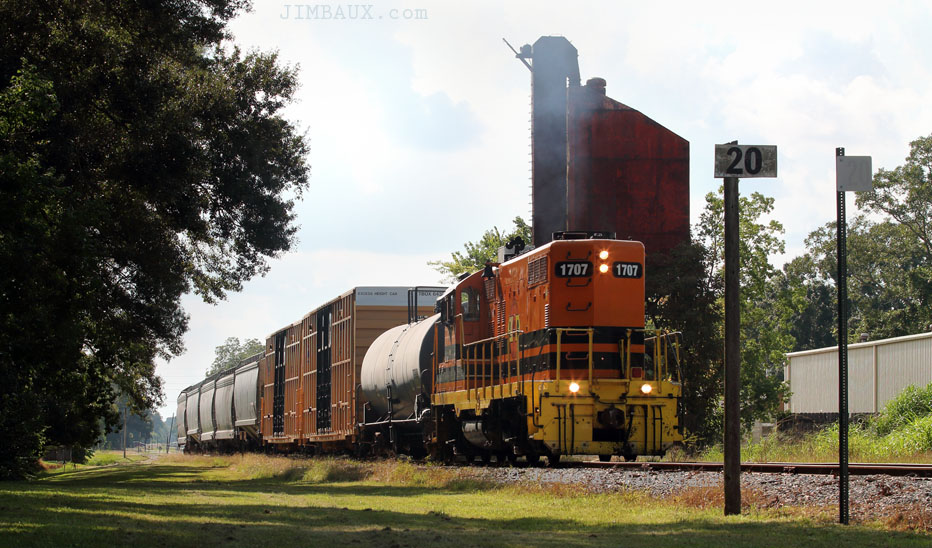
It’s also about the first, last, and only time that you’ll get a view of the train of all eight cars, because that tank car will soon be set out at Coastal Chemical, but not before I got this going-away shot at South Hospital Road.
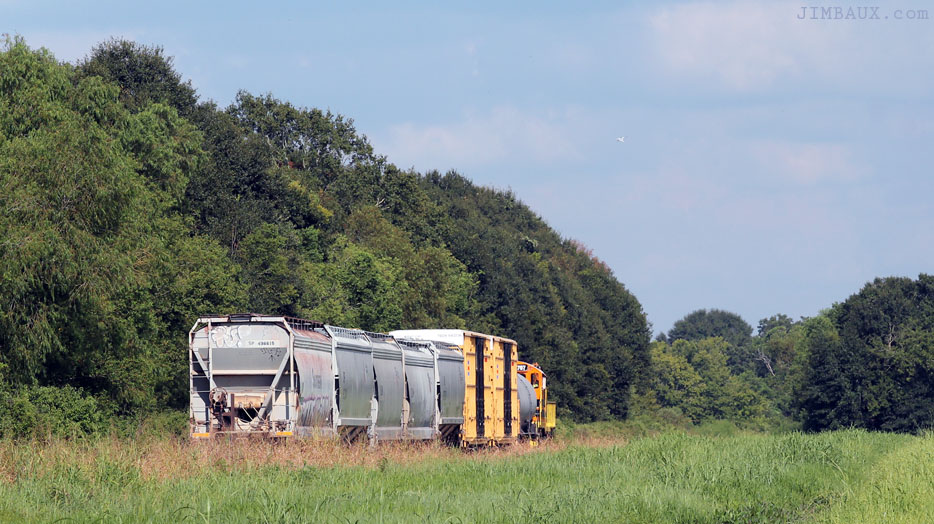
Perhaps I stopped somewhere and got a bite to eat while the crew and locomotive were spotting the tank car.
Anyway, here I am at the western edge of Erath, at Mack, for my highway swoosh shot.

Please notice that the locomotive pulling the train at 10 miles per hour on jointed rail where it has the sole authority to be has all of its headlights on, while these automobiles moving 50mph on a highway where they can and do shift lanes don’t have their headlights on.

Yes, I am pretty damned hardcore about people having their headlights on at any time while driving, particularly because it costs essentially nothing to do so, while the benefits to all are obvious.
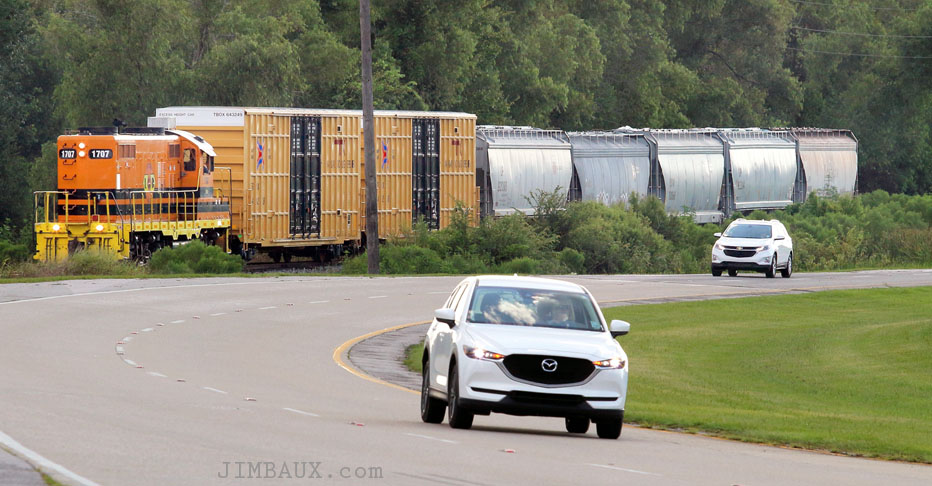
Look at those shiny new boxcars! They are making what is almost certainly their first shipment!

Believe me, I would, almost any day, prefer the boxcars of decades ago, but I’ll take this.

We are getting into Erath, by the ballpark here.
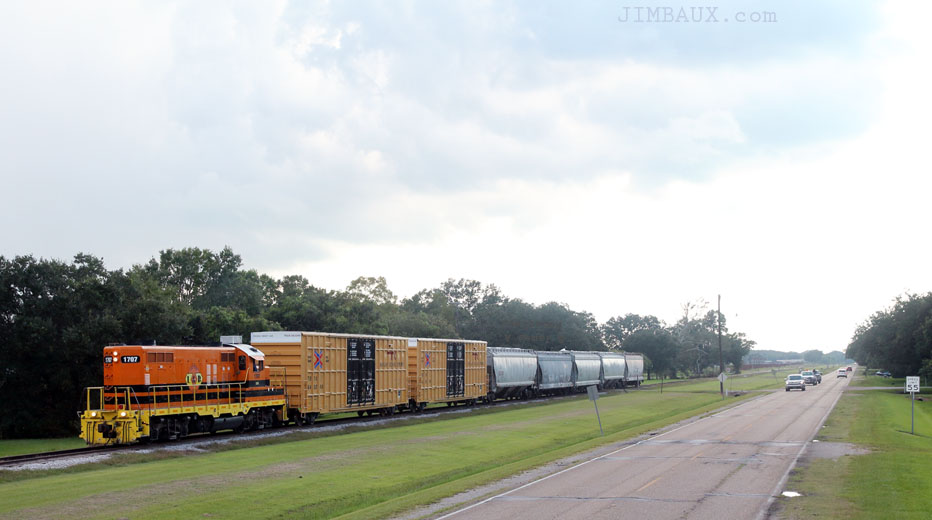
Baseball parks always bring back unpleasant childhood memories – and their even-more-unpleasant implications for my struggles in adulthood in this neurotypical society – for me.

I don’t fit into this society.

I like these cloudy shots east of town.
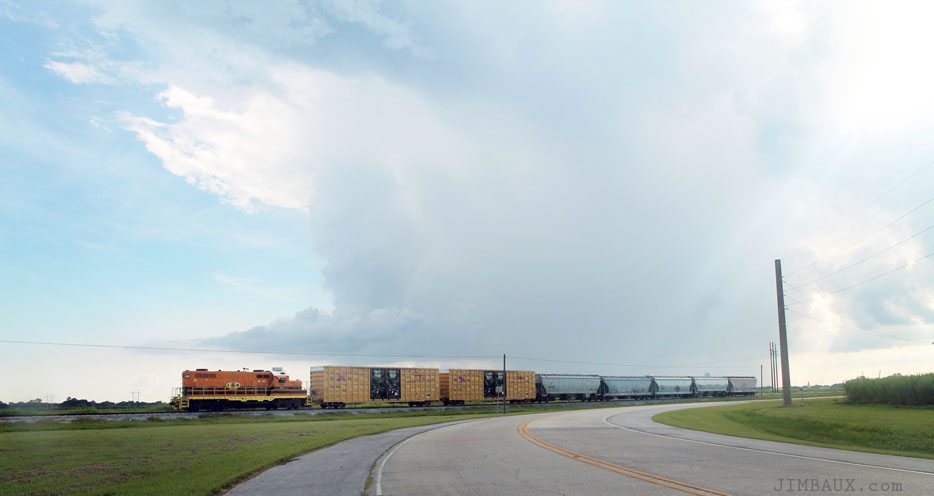
I also like broadside views.
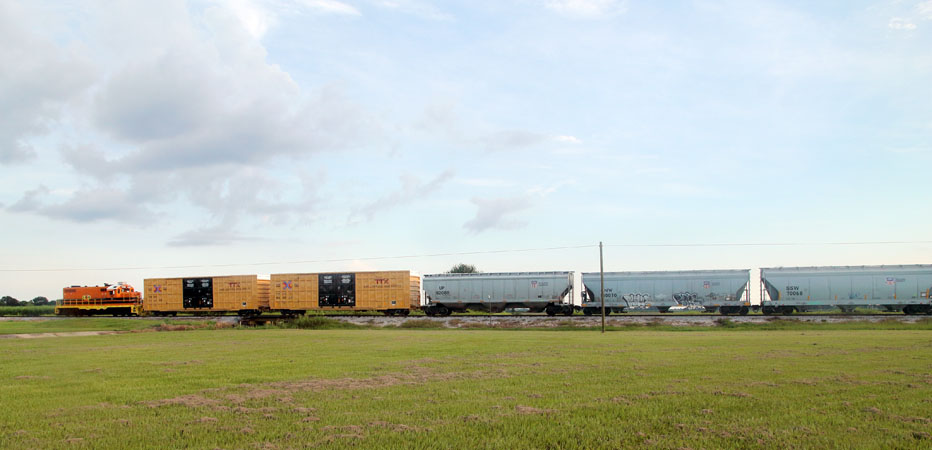
I imagined the more interesting rolling stock that one would have seen in this view in previous decades.
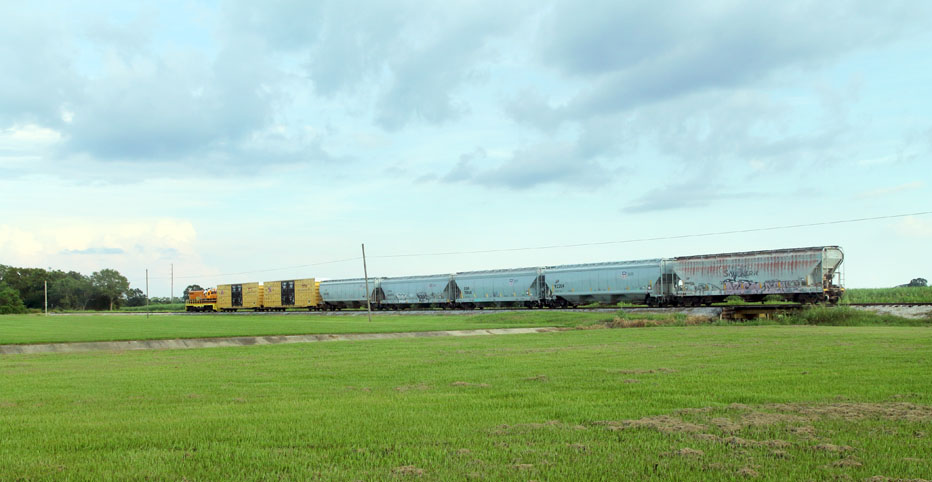
In Delcambre, near the elementary school, another kind of place of difficult childhood memories that make me think of my struggles in adulthood, I get the below image.
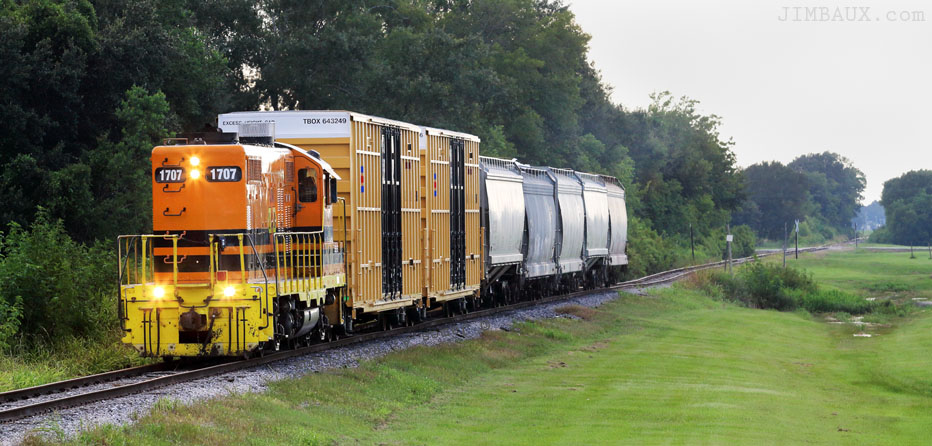
The train must stop for the canal lift bridge; with no trainman in an automobile accompanying today’s train, the train must stop, and the guy working the ground raises the span.
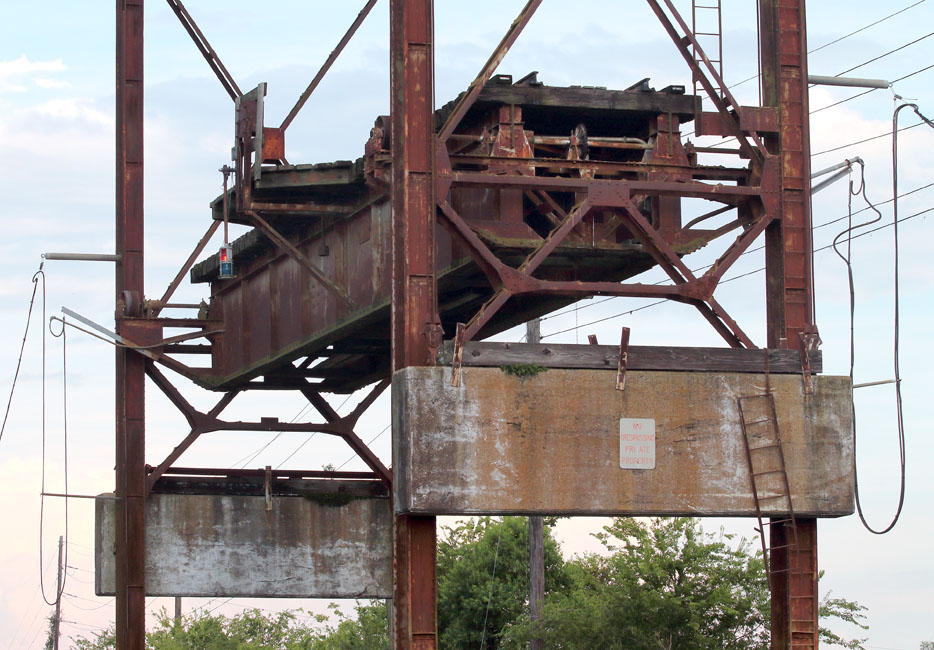
I don’t know exactly what he is doing here.
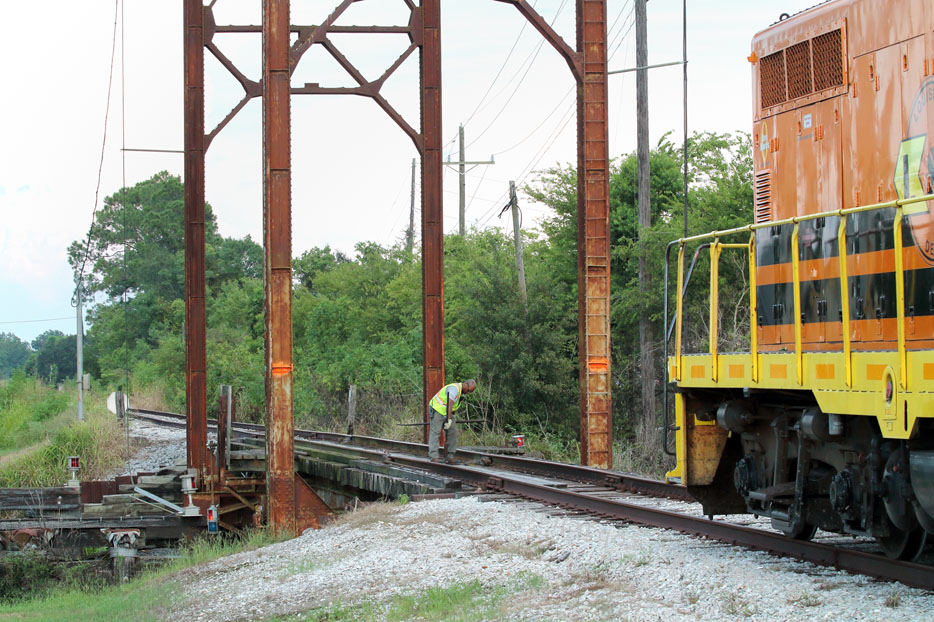
But he does!
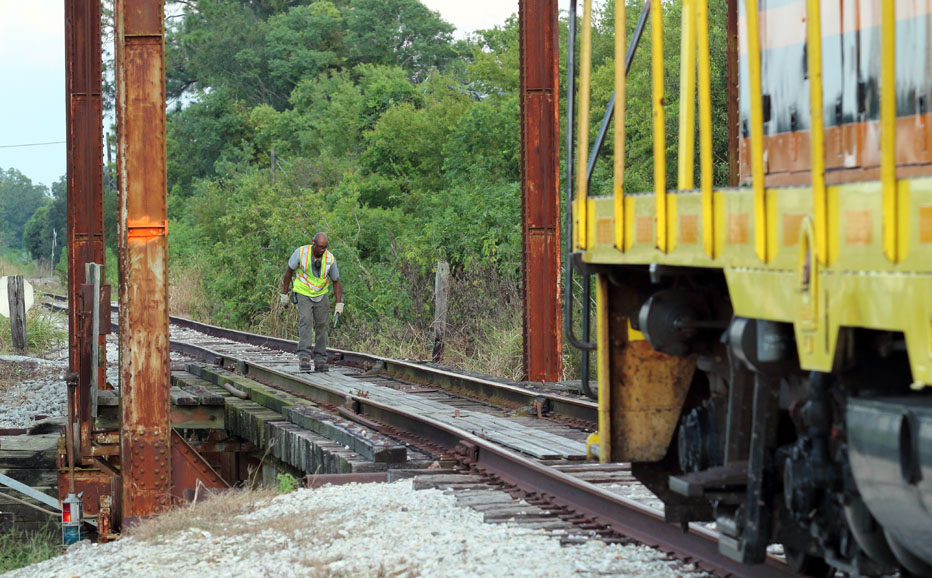
With the train through, it’s time to raise the span.
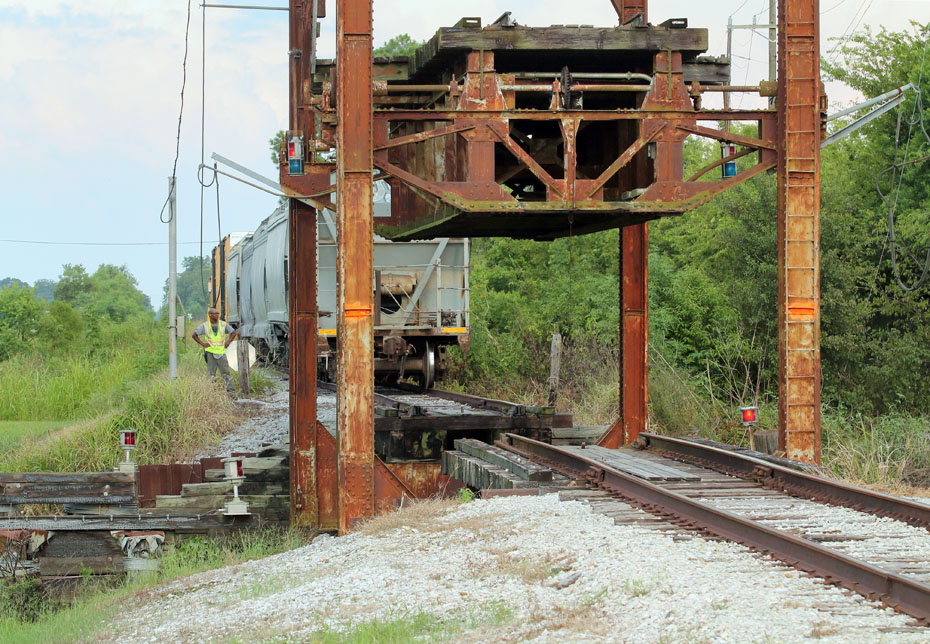
I decided that I would chase this thing all the way to New Iberia; the train was running slightly earlier than trains on the branch normally run, and I might be able to get some neat shots of it along the beginning parts of the branch.
Twenty-five minutes after the above image, I get the below image at I&V Junction.
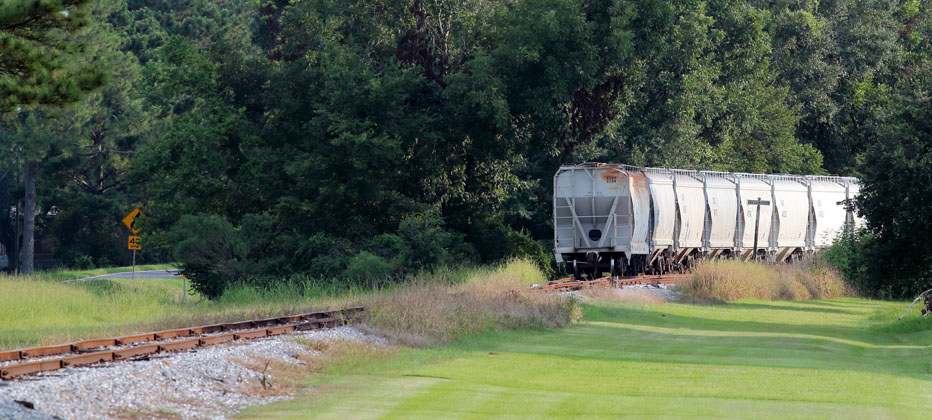
Those hopper cars are parked in storage on the beginning of what remains of the Salt Mine Branch to Avery Island past I&V Junction, which is difficult to see in this view, but there is a track going off to the right, and that is the track to Abbeville that our train has been using; the railroad to Avery Island was built first, and then the line to Abbeville was built from it, which is the reason for the indirect route that today’s Abbeville Branch has in comparison to Louisiana Highway 14 between New Iberia and Abbeville.
Sixteen minutes after I took the above picture, and 41 minutes after I took that image of the Delcambre bridge returning to the upright position, our train shows up.
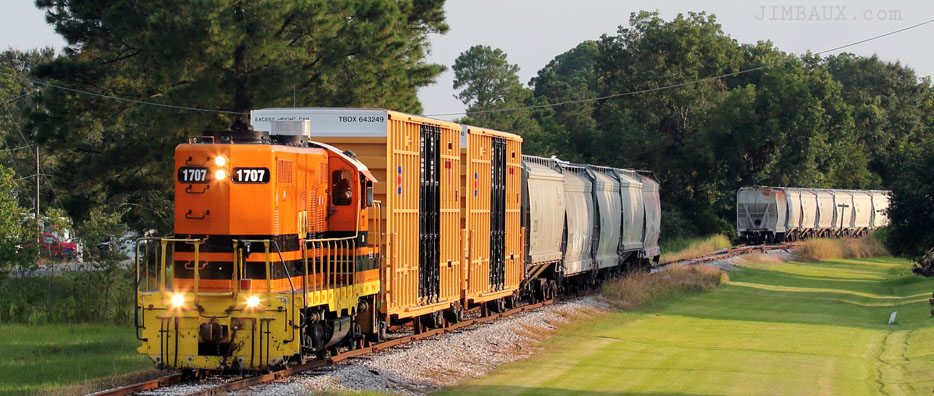
Four minutes and about a mile later, I am at C Broussard Road, where, before the train shows up, I get a view eastward across sugarcane fields to the Port Of Iberia.

That’s neat. Here is our train.
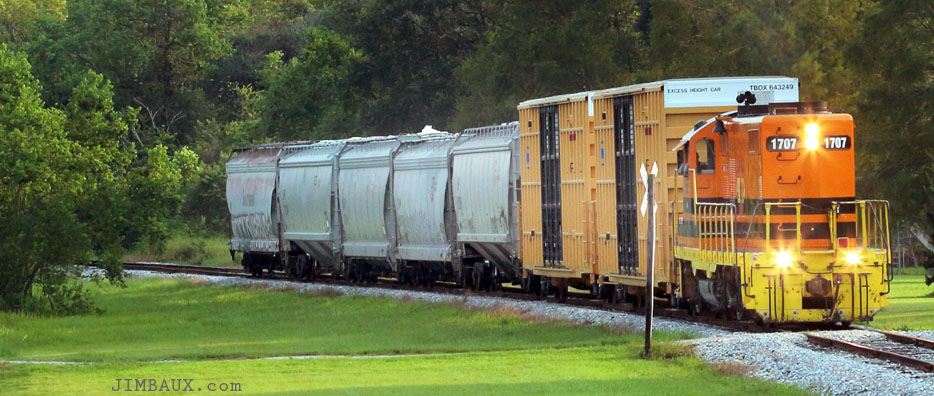
This is not bad, and I like the interplay between the freshly-cut lawns and the ballasted branchline railroad, with no ditches in between them.
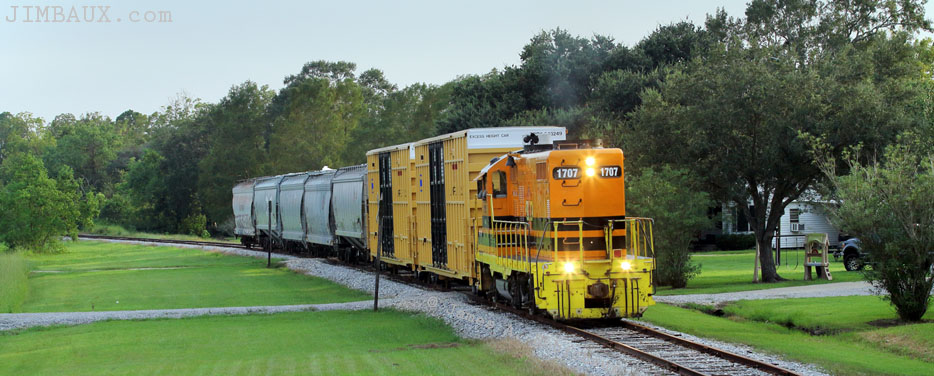
What I like better, though, is these longer views at Kenneth Road.
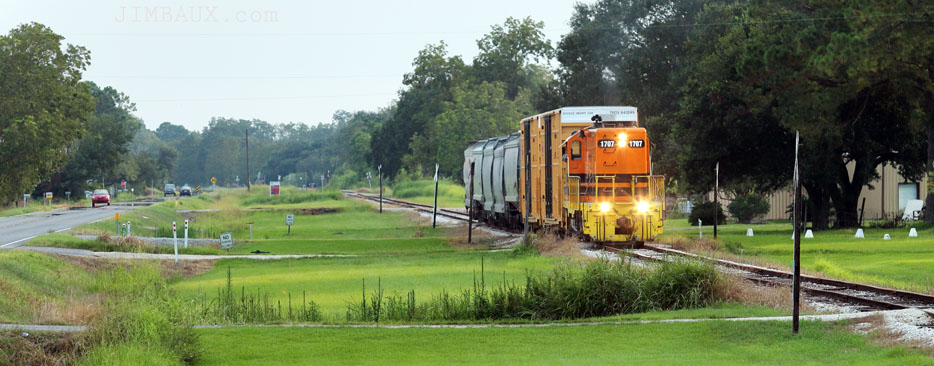
Here is that view cropped.

Wait, look at this! No, look a this, kid!
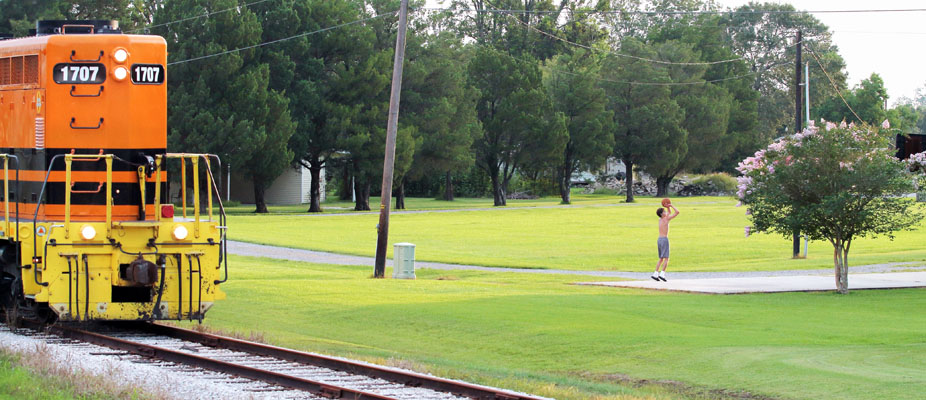
Boy, shooting hoops is important, but, as someone who grow up with a driveway by a branchline track that is no longer there, a driveway that also had a basketball goal on it, I can tell you that you should at least pause to observe the train’s passage!
The train has now ducked under US Highway 90 and is about to cross Highway 14 and enter town.
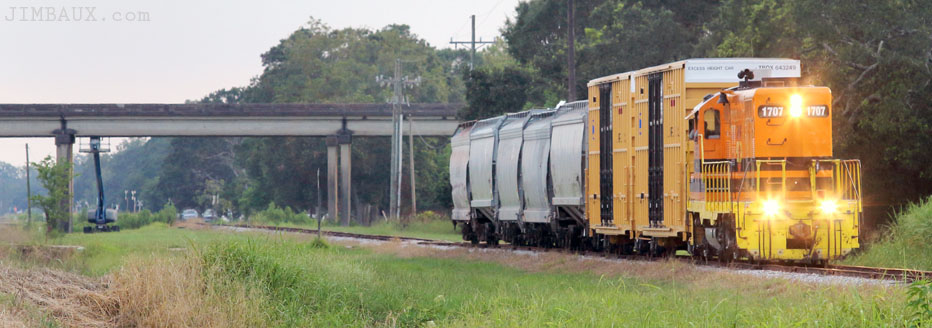
The train will end the day where it began the day, with the crew tying down the cars just south of Pershing Street, where the Missouri Pacific Railroad’s line to Patterson once ran.
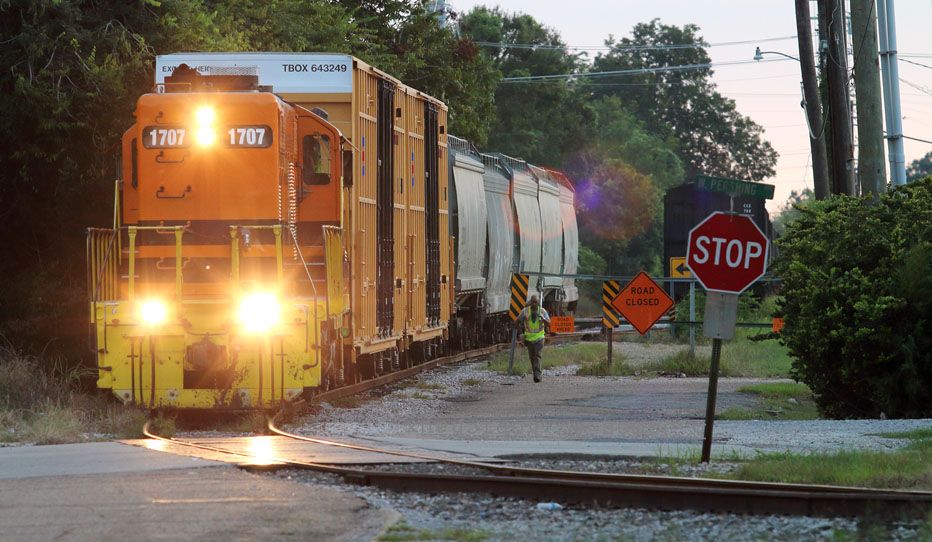
With the cars tied down, the 1707 crosses Pershing Street and comes toward the depot to tie down for the evening.
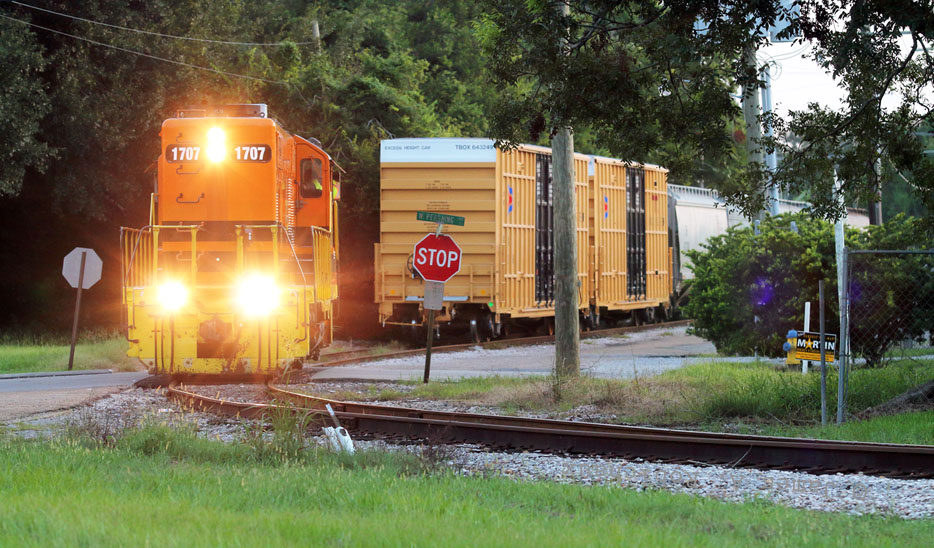
The workday is done, it’s 94 F degrees at 18:39 in New Iberia, and it’s time to go home.
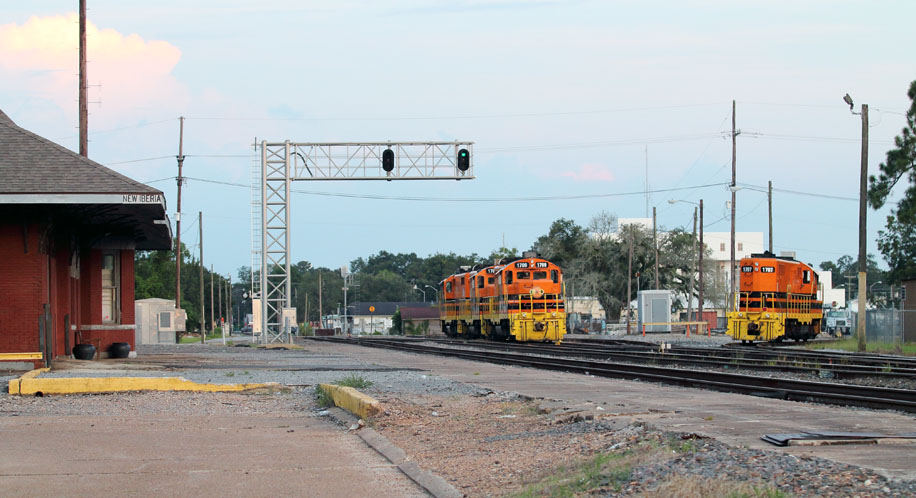
There is a note from my log of notes from the day that says that the “McDonald’s in New Iberia was the craziest,” but I have no recollection of why I wrote that.
Back in Abbeville, after and where I may or may not have stopped at Dairy Queen, I want to get some shots of the boxcars at the mill, and one of the newer ones is the one most visible!
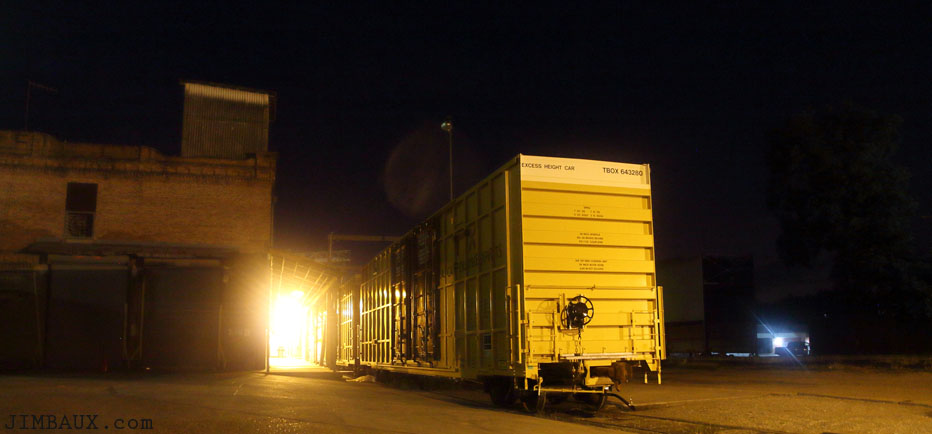
I like it.
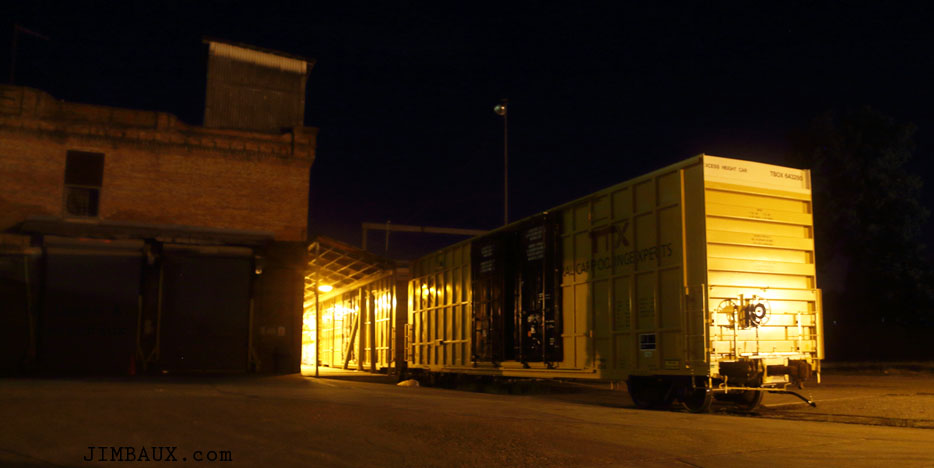
That was a day, wasn’t it? Let’s hope that I don’t take that many pictures again in the future.
If you liked what you saw here, you recognize that it requires both time and talent, you want to see more, and you have the means to help, please consider becoming, for as little as $1 per month, a patron of this publication.
Merci.
Jbx
